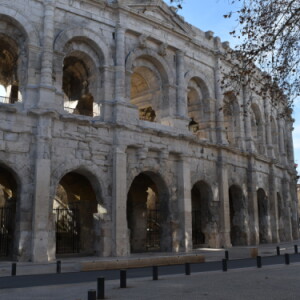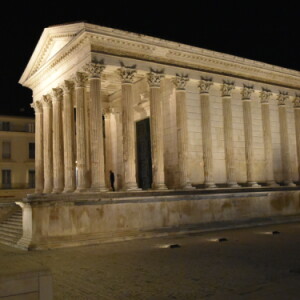Ah! Nîmes!
The day dawned bright and sunny – and warm, around 17-18ºC. After a quick breakfast at the hotel, I wandered out to the place d’Assas and looked around, before making my way to the Maison Carrée in the appropriately named place de la Maison Carrée. Unfortunately, it didn’t open until 10 – and I had a good 20 minutes to wait before that auspicious hour – so I went for a wander through the back streets of the old town. And what an old town in is.
I should probably warn you at this stage that if you have 20 minutes to kill before an appointment, don’t spend it wandering about the back streets of Nîmes, because you will lose all track of time and end up either very late or not bothering to attend the appointment at all. As I made my way down rue de la Madeleine, the buskers were setting up, and the wafts of “La vie en rose” and “Ne me quitte pas” were soon reverberating around the place de l’Horloge, if accordeon music can ever reverberate. The shops were opening, and I was pleased to see that they were all individual boutiques, small stores selling books and local produce, or restaurants taking delivery of fresh vegetables. Already I loved the place, and I’d only been out in the streets for 45 minutes.
At that, I panicked, as I wanted to go to the Maison Carrée before heading off to the big attraction, so decided to make my way up to the avenue Victor Hugo and along to the MC. When I got there, I looked again at it and couldn’t help but be impressed by the fluted columns extending all around the building. Inside, the effect was less spectacular. It’s not that I didn’t like it, but it really wasn’t what I was expecting. The inside really didn’t match the outside at all. While the columns give the impression of wealth and opulence, the inside is, well, sparse and almost barren. There were a couple of good interpretation boards, telling me what I was seeing, which helped. I learned, for example, that the temple is pseudoperipteral, without really telling me what pseudoperipteral means. I don’t know about you, but pseudoperipteral isn’t really a word I bandy about in general conversation – even though I have used it three times in the last two sentences.
Anyway, the temple was built by the Nîmes magistrates, who were brownnosing the Emperor Augustus to show them how loyal they were – and it gave Augustus the opportunity to develop his own cult, and to promote imperial architecture throughout the provinces. The walls were solid and had obviously been really well renovated at some stage, and the paint was still visible (although I suspect not entirely authentic). Still, the beauty of the outside certainly compensates for all of that, and it is worth a visit and the 6 Euro entrance fee.
After that I felt a little discouraged for some reason and so wasn’t overly in a hurry to get up to the Arènes de Nîmes, which is, of course, the aforementioned “main attraction” I was going on about. I’d pre-booked on line through booking.com, which had managed to save me the princely sum of minus 1 Euro, but I at least had the advantage of not having to queue up behind the one person who had not had the foresight to pay extra for the privilege. But once inside, oh my God. What a place. The audio guided tour is very good and very informative. One of the first things I learned was the difference between an “arène” and an “amphithéâtre”. An arène, which comes from the Latin for sand, is covered with sand. See how logical it is? This was to soak up all the blood and to stop the cloying odour of death from making all the patricians gag in the noonday sun. Very thoughtful, I’m sure. I mean, I don’t know about you, but while I love watching a lion being slaughtered or a gladiator being disembowelled by a vengeful cheetah, the last thing I want to smell while I am eating my bag of otters’ nipples is blood.
Not being a fan of blood sports in general (unless it involves Everton losing against Liverpool), I moved on and came to the section dealing with the Noonday Entertainment, which wasn’t far from the wonderfully named “vomitoire” (section P20 if interested). Warily, I listened.
Apparently, the midday entertainment consisted of executions, and was perhaps (at least according to the information I was being fed) the least popular part of a day at the arena. According to the rather patrician guide I was listening to, only the poor people and slaves stayed to watch. The poor people, because they wanted to keep their spots for the afternoon’s gladiatorial combats, and the slaves because they were forced to sit in the midday sun and keep the seats for their masters to take up later on. I supposed I was happy about this – about it not being completely a barbaric society, I mean – but somewhere along the line I can’t help but being glad I was born in the late 1960s and not the late 60s AD.
The information about the gladiator fights also painted a picture of a society less cruel than one might suspect. Apparently, very few gladiators were executed, mainly perhaps because they were so expensive to train and prepare for combat. While a lot of gladiators were probably killed in combat or died post-combat from wounds, etc., very few were killed at the whim of the crowd or the person presiding the games. Most gladiators were spared because they had fought bravely – and because the death would have meant the emperor would have had to pay the full price of the gladiator to the trainer. And the downward pointing thumb didn’t happen either. Pure Hollywood apparently.
The most delightful thing about the entire experience was the absence of people. There was a school of laughing Italian kids there, which somehow seemed appropriate, but other than that, I was perhaps one of a dozen people. The second most delightful part of it was being able to walk into the arena itself and move around the sandy floor unencumbered. And I was the only person there. I looked around from the ground floor into the rows and rows of benches and seats and tried to imagine what it would be like to have to strap on my breast plates, pick up a javelin, and fight to the death. Thankfully, I couldn’t, so I practiced a few thumbs up and thumbs down gestures (yes, I know they aren’t authentic, thank you very much) and realized I’d probably frighten my adversary to death with my post-Donald Trump hairstyle, through which the orange was somehow making a breakthrough, and headed out via the vomitorium to the street.
By this time, it was mid-afternoon and I was hungry, so I stopped off at a little café on place Belle Croix and had their menu du jour (entrecôte) and a couple of small carafes of the Gallician rouge. Then, I went back to the hotel and Skyped Mrs Ottawacker and Ottawacker Jr, regaling them with tales of gladiators and temples. Surprisingly, they were not quite as enraptured as I had been, so I decided to go out again and find something different to tell them about. I went to the cathedral instead, which was fine, sans plus, before going to sit under the shade of a plane tree in the gardens of the conservatoire, listening to young violinists respecting their local history by castrating unsuspecting cats without anaesthetic. Or something similar.
I wandered and wandered, went into various buildings such as the Église Saint-Paul and the Galérie Jules Salle, which was a splendid little place hosting an exhibition of local artists called “Le volcan qui gronde et brûle”. Some of it was of course appalling, looking like it had been done by three-year olds who had been told they had to finish their picture before getting some ice cream, but some was amazing. In particular, an Avignon artist called Stéphanie Brossard, had created a piece called “Upcycling”, in which she had crafted a Roman helmet out of small pebbles. Or maybe it was a balaclava. But it was brilliant, so I made a mental note to look out for her in the future and left the building and its incredibly friendly attendants to venture out into the waiting sunshine.




Comments
Sign in or get an account to comment.


